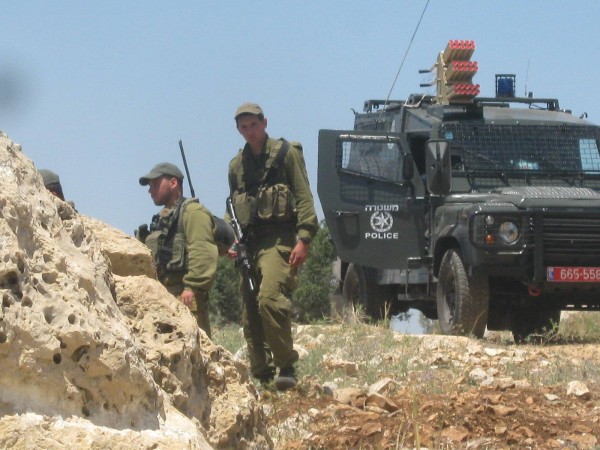26th May 2014 |International Solidarity Movement, Nablus team | Kafr ad Dik, Occupied Palestine
Early yesterday morning, at approximately 05:00, two drilling machines were at work in Daher Sobeh, at the top of a mountain in the eastern part of Kafr ad Dik, an area where there are many water springs.
Together with the machines, there were a large number of settlers from nearby illegal settlements, a tent with Israeli flags, and four military jeeps, with approximately 40 soldiers. According to several witnesses, the land grab could sum up 600 dunums (60 hectares).
When the first farmer arrived on his land at 06:00, the area had already been declared a closed military zone. When he asked why there where machines at work, and why he was not allowed to access his land, he was told that the area was closed for “security reasons”. He was later handcuffed and detained for almost two hours when he attempted to access his land.
In the following hours, other villagers arrived at the area to protest, together with international activists and Palestinian media, documenting the construction. The Israeli military reportedly stated that if they continued to take photographs, local olive trees in the area would be burnt.
The villagers remained in the area for approximately three hours, but only the mayor of Kafr ad Dik was allowed to speak with the Israeli captain. The mayor stated that the soldiers claimed to operate under a military order, but no documents were ever shown. International witnesses reported that this military zone was arbitrary, allowing some people through but stopping others.
These events followed the previous Thursday; where there was a first attempt to take over the land. Thursday, 22nd, May, in the early morning, approximately 30 Israeli soldiers and border police officers, together with a dozen settlers and one bulldozer, entered the area. The villagers started to protest, involving around one hundred people from Kafr ad Dik and other villages in the area, Israeli forces left at approximately 15:00.
The Israeli captain working with the DCO [District Coordination Office] in the area (Salfit and Qalqilya) was present on Thursday. Before leaving he stated that they would come back. When Israeli forces returned on Sunday morning, they claimed to have governmental approval and that any complaints should be taken to the court.
Furthermore on Thursday night, undercover Israeli police arrested a 34-year-old man in the town. A villager in the town stated that Israeli border police stopped a Palestinian car and took the vehicle. With this car, and without uniforms, they entered in Kafr ad Dik and stopped in front of a supermarket, taking the owner, Wafee at Turc. No further information is available.
The first attempt to build in this area began in 1992, when the construction was stopped by a court decision. After this, there were a further two occasions when settlement expansion was attempted. Currently the municipality together with the owners of the land are trying to take this land seizure to the Bet’el court. This can take two or three years, and there are no guarantees of an impartial court.
The Kafr ad Dik area is actually the table plane of water of the West Bank, although, the people of Kafr ad Dik are only allowed to use 300 cubic meters of water per day, in a town populous of about 6,000. The governing body in the town has asked for an increase in water supply, to no avail.
As suggested by many sources, this attempt is made in order to increase the size of the already large illegal settlement of Ari’el, linking it with all present and future illegal settlements in the area. Kafr ad Dik is actually surrounded by four illegal settlements (Ale Zahav, Pedu’il, Bruchin, and Lesh’ev), while the only area fully available to the village is the one between the village itself and Ben Ghassan. Of the 16,500 dunums owned initially by the village, over the 80 % is under Area C [full Israeli civil and security control]. Some Palestinians have suggested, this is just one step to a further expansion of the Annexation Wall, made in this area in order to divide the West Bank into two parts.


